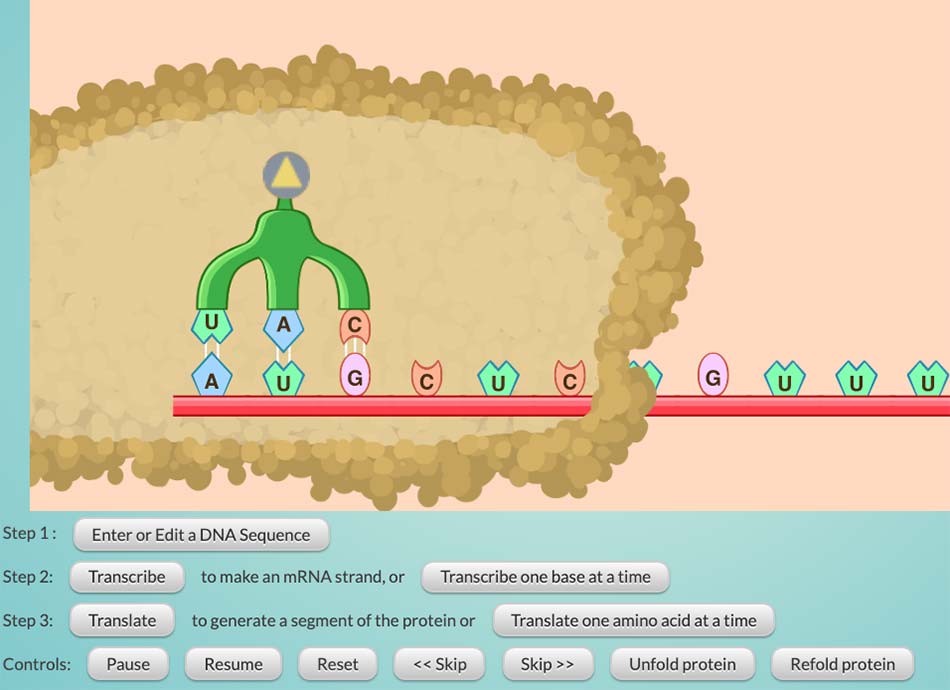
Many students think that all mutations influence phenotype. They learn that protein structure, and consequently protein function, is determined by a DNA nucleotide sequence. However, many students do not realize that a change in the nucleotide sequence can have a large, small, or neutral effect on the protein. In this lesson, students use the ConnectedBio Protein Synthesis Simulation to mutate a DNA nucleotide sequence, transcribe and translate it, and observe the resulting protein. Students deepen their understanding of the relationship between DNA and proteins, focusing particularly on the direct impact of mutations on the amino acid sequence.
Part 1: Explore
Launch the ConnectedBio Protein Synthesis simulation.
- Enter this DNA nucleotide sequence (avoid extra spaces!):
ATGCTCTGTTTTATCTACGTCTCACCAACAGCCCATCAGAACAAGGATGAGTGGCGAAGCGGA - Click Transcribe and watch the simulation.
- Click Translate and watch the simulation.
- Examine the resulting protein.
- Click the amino acids to learn their names.
- Take a screenshot of the protein.
- Describe the process in the simulation to a partner. What happens?
Part 2: Make Guided Changes
- Substitute an A for the ninth nucleotide. Click Edit the DNA
nucleotide sequence and manually change it OR press ‹‹Skip
until you see the DNA strands, click on the ninth nucleotide on
the TOP strand, and substitute the T for an A.
- Rerun the simulation and examine the resulting protein
- Compare the new protein to your screenshot from Part 1.
- Substitute a C for the ninth nucleotide.
- Rerun the simulation and examine the resulting protein
- Compare the new protein to your screenshot from Part 1.
Part 3: Discuss
As a class, discuss:
- Does a DNA mutation always change the protein? Why or why not?
- What is a stop codon and what does it "stop" from happening?
- In addition to substitution mutation, in what other ways can a DNA nucleotide sequence mutate?
Part 4: Predict and Investigate
Challenge students to:
- Determine how many ways they can alter a given codon (set of three nucleotides) but keep the amino acid the same. (Answer: Some amino acids can only be made by a single codon, while others, like Leucine, have six possible codons.)
- Make the largest possible number of changes to a given sequence without changing the resulting protein.
- Change a few nucleotides in a given sequence and describe how the shape of the resulting protein changes. Take screenshots. (Note: Some amino acid changes alter shape, while others have similar properties to the original amino acid, leading to a similar shape).
- Insert or delete one or two nucleotides somewhere in the given sequence and examine the effect.
Part 5: Share
Students present screenshots of their new proteins, describe what they found, and debate answers to the challenges in Part 4.
Part 6: Research the Impact of Mutations
Divide students into groups to research and present on the following questions:
- What is the difference in impact when a mutation occurs in a sex cell versus in a somatic cell?
- What do proto-oncogenes do? How do mutations in them influence an organism?
- What are "proofreading" and "mismatch repair" and how do they work?
The ConnectedBio curriculum
The ConnectedBio curriculum helps students create a network of connected biological concepts spanning multiple scales—from the population, organism, molecular, and heredity levels—using a series of online interactive lessons.